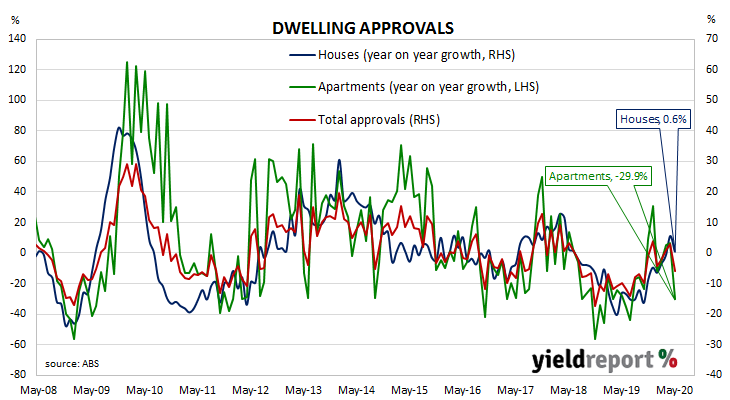Summary: Home approval numbers dive; fall worse than expected; house approvals down moderately while apartment approvals plummet; non-residential approvals down for fourth consecutive month; recent figures down only modestly in absolute terms.
Approvals for dwellings, that is apartments and houses, had been heading south since mid-2018. As an indicator of investor confidence, falling approvals had presented a worrying signal, not just for the building sector but for the overall economy. However, approval figures from late-2019 and the early months of 2020 painted a picture of a recovery taking place, even as late as April.
The Australian Bureau of Statistics has released the latest figures from May and total residential approvals dropped by 16.4% on a seasonally-adjusted basis. The fall over the month was much worse than the -6% which had been generally expected and it was a much larger fall than April’s 2.1% decline. Total approvals decreased by 11.6% on an annual basis, a marked deterioration from April’s comparable figure of +6.1% after it was revised up from +5.7%.
“Importantly, the detail points to further downside ahead,” said Westpac senior economist Andrew Hanlan.
 The figures came out on the same day as the AiG’s June PMI report and Commonwealth bond yields increased noticeably at the long end, more than their US Treasury counterparts had in overnight trading. By the end of the day, the 10-year Treasury yield had gained 6bps to 0.95% while the 20-year yield finished 7bps higher at 1.57%.
The figures came out on the same day as the AiG’s June PMI report and Commonwealth bond yields increased noticeably at the long end, more than their US Treasury counterparts had in overnight trading. By the end of the day, the 10-year Treasury yield had gained 6bps to 0.95% while the 20-year yield finished 7bps higher at 1.57%.
Prices of cash futures contracts moved to reflect a slight softening of rate-cut expectations. By the end of the day, July contracts implied a rate cut down to zero as a 59% chance, down from the previous day’s 62%. August contracts implied a 53% chance of such a move in that month, unchanged from the previous day. Contract prices of months later in 2020 and through to the latter part of 2021 implied similar probabilities, ranging between 41% and 57%.
Westpac economists are not the only ones to expect further falls this year. “We expect continued weakness in building approvals this year. Lower population growth in the near term, combined with job and income losses in industries with high shares of renters are key factors in the weak outlook for housing demand,” said ANZ economist Adelaide Timbrell.

